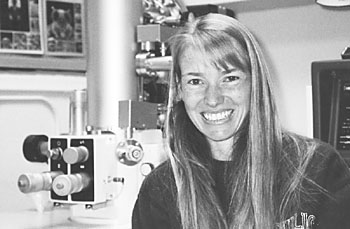

April Davis: Published Researcher
 If April Davis were to choose a motto,
"nothing ventured, nothing gained" might do well. The California
native moved here to attend college after falling in love with Hawai`i
while on vacation. Fascinated by the microscopy images in their textbooks,
Davis and a friend found their way to UH Manoa's electron microscope facility in Snyder Hall and asked if
they could learn to use the equipment. Facility Supervisor Tina Carvalho
gave them a tour and sent them on their way. When Davis returned, offering
to pay for microscope time, Carvalho knew the undergraduate was seriously
interested. She referred Davis to researcher Petra Lenz, who had an opening
for a student with the hardy good nature to weather rainstorms and rough
waters while collecting samples from Kane`ohe Bay and the painstaking control
to prepare transmission electron microscope sections so thin they are moved
about with an eyelash hair. Davis took to the job like a zooplankton to
water. "Copepods just sucked me in," she says.
If April Davis were to choose a motto,
"nothing ventured, nothing gained" might do well. The California
native moved here to attend college after falling in love with Hawai`i
while on vacation. Fascinated by the microscopy images in their textbooks,
Davis and a friend found their way to UH Manoa's electron microscope facility in Snyder Hall and asked if
they could learn to use the equipment. Facility Supervisor Tina Carvalho
gave them a tour and sent them on their way. When Davis returned, offering
to pay for microscope time, Carvalho knew the undergraduate was seriously
interested. She referred Davis to researcher Petra Lenz, who had an opening
for a student with the hardy good nature to weather rainstorms and rough
waters while collecting samples from Kane`ohe Bay and the painstaking control
to prepare transmission electron microscope sections so thin they are moved
about with an eyelash hair. Davis took to the job like a zooplankton to
water. "Copepods just sucked me in," she says.
Now a candidate for a master's degree in animal science, Davis says the benefits of her job extend far beyond the paycheck and practice at time management. Lenz and her colleagues are "wonderful mentors and a great source of support," she says. "They read my essays and helped me apply to veterinary school. I learned neuroscience from them that wasn't really available in a class."
"An undergraduate gets a better education if he or she works in a job in a research lab," confirms Daniel Hartline, Lenz's husband and research colleague at the Pacific Biomedical Research Center.
Always interested in becoming a veterinarian, Davis now plans to pursue a PhD as well. "I can't imagine not doing research," she says.
She has a good head start. Her unexpected observation of specialized nerve structures in microscope images from the samples she prepared alerted researchers to a major finding that alters basic biological assumptions. As a result, she is co-author on a publication in Nature with Carvalho, Hartline and Lenz. Being published in the British journal is an honor for any scientist--and a rare feat indeed for a student who has yet to begin doctoral training.
But then, nothing ventured, nothing gained.